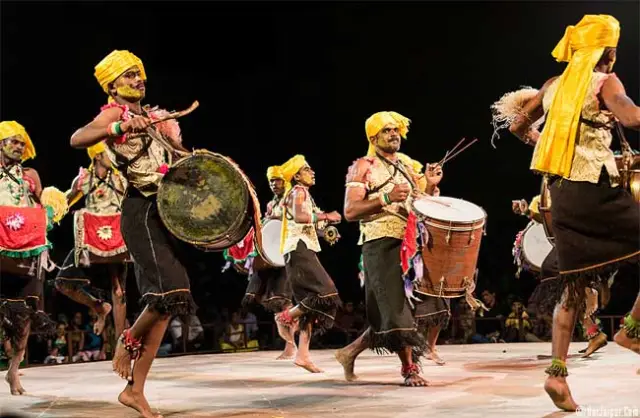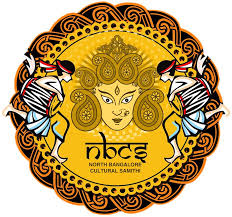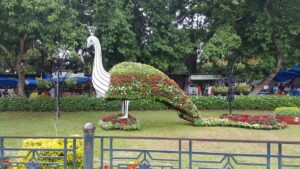
Bangalore, which is now formally called Bengaluru, is more than simply the centre of information technology in India. A rich cultural tapestry woven with centuries of history, folklore, and creative expression may be found underneath its global hustle. Classical and folk art forms that capture the essence of Karnataka have been nurtured in the area around Bangalore, particularly in the ancient Mysore area. In this area, folk art, music, and dance are living traditions that have been passed down through the centuries rather than just performances. These artistic expressions provide a vibrant window into Karnataka’s cultural legacy by capturing the spirit of rural life, religious devotion, and social critique.
The Essence of Folk Art in Bangalore Region
In the Bangalore area, folk art is a grassroots way for people to express their sense of place. Folk art is impromptu, intricately linked to local culture, and profoundly metaphorical, in contrast to classical art, which is frequently polished and standardised.
Lepakshi painting is one well-known folk art form; although it is more strongly linked to Andhra Pradesh, its impact can be seen in the border areas adjacent to Bangalore. This style, which features vivid colours and mythical motifs, is used in both rural dwellings and paintings in temples.
Nearer Bangalore, rangoli, sometimes called muggu or kolam in the local dialect, is a daily custom in many homes. At the door of their houses, women use coloured powders or rice flour to make elaborate designs. In addition to being aesthetically pleasing, these rangolis have cultural and religious meanings that invoke blessings and fend from evil.
Making leather puppets for Togalu Gombeyaata, the ancient shadow puppetry of Karnataka, is another important folk art form. These elaborately painted and sculpted puppets frequently depict legendary scenes from the Mahabharata and Ramayana. In addition to being beautiful works of art, puppets serve as useful storytelling instruments and are a vital component of rural education and entertainment.
Folk Music: The Voice of the Land
In Bangalore and the neighbouring regions, folk music is passed down orally. It is frequently played without written notation and transmitted via festivals, ceremonies, and community meetings throughout generations. Themes of nature, love, devotion, and everyday country life are frequently reflected in this intensely emotional work.
Songs of the people, or Janapada Geethegalu, are among the most popular kind of folk singing in the area. These Kannada-language songs convey the hopes, dreams, and griefs of common people. These melodies, accompanied by indigenous instruments such as the tamburi, maddale, nagari, and dollu, are the focal point of village meetings and local festivities.
Bhavageethe is another potent form that combines song and poetry. Bhavageethe has a strong grassroots appeal and frequently uses folk tunes, although not being wholly folk in nature. This approach has been used to sing the works of well-known Kannada poets like Kuvempu and D. R. Bendre, bringing literature closer to the general public.
Additionally, religious folk music is ingrained in the society. During temple festivals and other religious events, the saints of the Haridasa movement often sing their devotional songs, known as Haridasa Keerthanegalu. These hymns, which honour Lord Vishnu, are brimming with spiritual devotion and philosophical insight.
Folk Dance: Movement and Meaning
One of the most colourful manifestations of traditional culture in the Bangalore area is dance. These dances, which combine rhythm, costume, music, and narrative, are frequently performed outside during festivals, weddings, and harvest celebrations.
The most well-known of them is Dollu Kunitha, a strong drum dance that Kuruba men do. Dancers beat out rhythmic patterns while walking in unison and carrying big drums that are fastened to their bodies. Frequently performed in honour of Lord Shiva, the ferocious dances and loud rhythms symbolise power, dedication, and communal spirit.
Veeragase is another well-known dance that draws inspiration from Hindu mythological stories of bravery. Men costumed as warriors typically practice this strenuous dancing style. With a special emphasis on the tale of Veerabhadra, a ferocious manifestation of Lord Shiva, Veeragase depicts themes of sacrifice, dharma, and resistance.
Using long poles adorned with vibrant ribbons, Pata Kunitha is a traditional dance that is less well-known yet visually arresting. Dancing to the rhythm of traditional instruments, the dancers whirl and balance the poles. It is a common sight at processions and rural fairs.
Karaga dance, which has its roots in Bangalore’s Tigala community, is particularly noteworthy. This dance, which is performed at the well-known Bangalore Karaga festival, is a spectacle as well as a religious rite. As a sign of devotion to Draupadi, the heroine of the Mahabharata, male priests costumed as women dance through the night while holding a flower-decked pot (karaga) on their heads.
Festivals and Performances: Where Art Comes Alive
The region’s numerous festivals and melas are the ideal times to enjoy these art forms. Folk performances that include dance, music, and storytelling are common during festivals like Rajyotsava, Karaga Mahotsava, and Kadalekai Parishe in Basavanagudi.
These customs are also promoted and preserved by public and private programs such as the Karnataka Janapada Academy, Rangayana, and folk art events hosted at Bangalore’s Ravindra Kalakshetra and Chitrakala Parishath.
Folk musicians play for sizable crowds on street corners, on temple grounds, at school events, and on outdoor stages, guaranteeing that the legacy is not only conserved but also proudly honoured.
Preserving the Folk Legacy in a Modern City
Bangalore’s identity is being shaped by contemporary influences and its fast urbanisation, but there is also an effort to conserve its folk culture. By supporting artists, holding seminars for folk training, and incorporating folk art into school curricula, several NGOs and government initiatives currently seek to preserve these customs.
Additionally, fusion performances—whether in dance, theatre, or music—are becoming more and more popular. When traditional customs are presented in contemporary ways without sacrificing authenticity, younger generations are becoming more interested.
Conclusion
In the Bangalore area, folk art, music, and dance are not artefacts of the past; rather, they are dynamic customs that preserve their cultural roots while evolving. They provide a rich cultural contrast to the metropolitan character of the metropolis and capture the essence of rural Karnataka. A trip into Bangalore’s folk customs is illuminating for anybody looking to discover the city’s character outside of its tech clusters and coffee shops. Bangalore’s folk culture narrates ageless, inclusive, and vibrantly alive stories through drumbeats, poetry songs, colourful puppets, and religious dances.





Leave a Reply